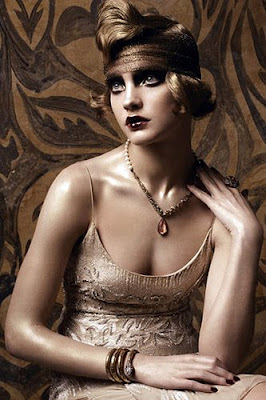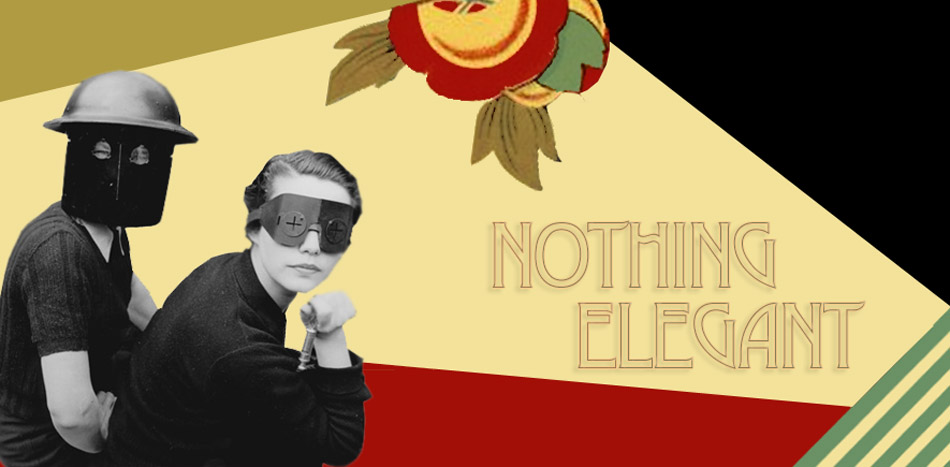I am completely smitten by the exotic Belle Epoque designs of French fashion genius Paul Poiret. A recent article on the blog Comunidade de Moda re-inspired my passion, and I have translated bits of the article on Poiret by Mari Yaghi (with a bit of help from Babelfish) -- hope you enjoy!
[There was a retrospective at the MET in 2007 of Poiret's work, which I unfortunately missed! (click on the link to see more of his designs). Were any of you lucky enough to see it?]


"Half a century before the feminists of the 60's were burning their bras, the Frenchman Paul Poiret (1879-1944) had already set women free of another restraining undergarment --the corset. Poiret became a celebrity for liberating women from uncomfortable corsets and creating a looser and more untied silhouette based on art-deco forms. The strict silhouettes and pale colors of the 19th century gave way to a new silhouette of untied dresses and chemisiers, unsewn, draped fabrics, and dramatic, oriental-inspired colors.


Creator of bohemian-chic, at the height of his career [before the 1st World War] Poiret was the king of the fashion. It can be argued that, with his groundbreaking vision, Poiret was the first truly modern designer. Much of the inspiration for the coats, dresses, and accessories on runways today originated in Poiret's designs of almost 100 years ago. While Chanel takes credit for creating the standard of modern fashion, Poiret is, according to Harold Koda [head of the Custom Institute, the department of Fashion of the Metropolitan] the true source of modern shape and forms. With his marketing savvy, Poiret was also one of the first designers to put his brand name on perfumes, cosmetics and decorative objects -- a strategy that is today the financial pillar for many great designers.


Poiret started to draw dresses while working in an umbrella factory in the mid-1890's. In 1898, he was contracted as an apprentice of the designer Jacques Doucet, from whom he absorbed many of the strategies he used later. In 1901, he left Doucet's ateliêr and went to work with Charles Frederick Worth, the designer who dominated the French fashion industry at the end of the 19th century.
[The dress below is a typical dress by Charles Frederick Worth -- notice the pale colors and the strict, corseted bodice popular in late 18th century French fashion]

[The loose, draped styles and bright colors of Poiret contrast dramatically with Worth's designs:]


Poiret opened his own proper ateliêr in 1903. Poiret was not skilled at sewing, but it was his lack of technical training that facilitated the advancement of his famous draping technique. A passionate lover of painting, he was the first one to use modern art to represent his creations. Partnering with the artist Paul Iribe in 1908, he published "Les Robes de Paul Poiret" and, in 1991, he produced "Les Choses de Paul Poiret' with fashion illustrator Georges Lepape. The work of Poiret was inspired by the dominant artistic trends of the day, such as classicism, orientalism, symbolism, and primitivism. With inspiration in art nouveau, the east, and the exotic ballets of Sergei Diaghilev's Ballet Russe, he introduced to high fashion the lively colors of the fauvists, and created layered dresses, skirts, and turbans that earned the description, "Pasha Paris".

Poiret's success was also due in part to his wife Denise, a young lady from the provinces whom he married in 1905. She was his muse, creative director of the fashion house, and, above all, his favorite model. In an interview in a magazine in 1913, Poiret affirmed: `My wife is the inspiration for all my creations, she is the expression of all my ideals.' The thin figure of Denise was the basis for his feminine clothing sketches. He began eliminating the corset in his designs as early as 1906, after his first daughter Rosine was born. Perhaps also as reply to Denise's second pregnancy, in 1910 he designed an untied dress, similar to a chemise. On the couple's first trip to New York in 1913, Denise was famously photographed in the Hotel Square resting on cushions (above). Denise also had a designer's eye -- fashion magazines indicated that she was the first to wear silk shoes without a bow or buckle. She was a brilliant stylist in the way she combined accessories, and she was the inspiration for Poiret's introduction of “high, wrinkled morocco boots” into the world of modern fashion. Styled with a low heel and a square toe, she wore them “wrinkled on the legs, nearly to the knees”, paving the way for the myriad of boot-skirt combinations women wear today.


Between 1910 an 1913, Poiret's designs were inspired by the ostentatious costumes of the Ballet Russes in Paris and by exotic oriental tales such as 1001 Arabian Nights -- he is credited with the introduction of turbans, tunics, and harem pants into Western fashion. Poiret, however, lost his position as king of fashion when the sober shapes and colors of Coco Chanel entered the scene in the 1920's. As the famous, and perhaps apocryphal, story is told, of the 1920's chance encounter between the "King of Fashion" and young Coco Chanel: Poiret inquired of the black-clad Chanel, "For whom, madame, do you mourn?" to which Chanel replied, "For you, monsieur."In the 20's, reacting against the new fashion inspired by Chanel that turned, in his opinion, women into boys, Poiret seemed to have lost his innovative touch and in a last desperate effort, attempted to reintroduce the suffocating corset back into his clothing designs. In 1928, Poiret and Denise divorced, and many of his original designs were kept stored away until the retrospective exhibition at the MET in 2007."


Below are the photos from a gorgeous fashion spread in Vogue (2007) inspired by the designs of Poiret in correlation with the MET exhibit:












US Vogue May 2007
Fashioning the Century by Hamish Bowles
Natalia Vodianova
Styled by Grace Coddington
Photographed by Steven Meisel
Fashioning the Century by Hamish Bowles
Natalia Vodianova
Styled by Grace Coddington
Photographed by Steven Meisel













16 comments:
Interesting article and lovely photos! What an inspiration!
xxx
like madeleinmrianda said, this was an interesting article! & i'd choose the baguette over the fendi any give day too!
xoxo,
La C.
Those pictures from Vogue are some of the most gorgeous things I've ever seen! I love each and every one of the outfits, and that's a first for me. Guess which magazine I'll be buying tomorrow? ;) And it's perfect timing too, since I recently tore down all the posters and things from my walls to start decorating all over again.
Oh, just noticed that the magazine was from 2007... well, I'll just print them next time I'm in my hometown and have a printer available!
Yes! I made a trip to NY specifically to see the Poiret exhibit and it was sooooooo worth it. He is one of my all time favorite designers, and finding a Poiret is my Holy Grail of vintage searches.
What a beautiful article, thank you for the information! The Vogue spread in 2007 is exquisite, as are Poiret's garments.
What a beautiful article, thank you for the information! The Vogue spread in 2007 is exquisite, as are Poiret's garments.
I did see the Poiret exhibit and it was truly lovely. Thanks for this article. I just love looking at his clothes.
oh thank you for your comment ! i love here ! see ya, love
Thank you very much for such an interesting informative post!
All the dresses are gorgeous and the Vogue (2007) photos are just amazing.
I love all things art deco. I have that first illustration in my room. I absolutely love your blog. It's so pretty!
okay, not to spoil the party, but 2 beefs: one, does this poiret REALLY deserve the credit for women geting tired of corsets corsets?!?!?! grrrrrr...no!
two, i think i'd rather wear a corset than the 2007 vogue piece (upper left-hand corner pic) especially with that awful head bow!
but i did love that quip from coco chanel :)
spring -- I love your comments, LOL. I guess in popular-fashion terms (and in France), he and his wife were very influential in taking corsets out of high fashion, but there were plenty of men and women that had been trying dress reform since the Victorian era. I like the head-bow, dammit!
The Poiret exhibit at the Met was pretty awesome :) I happened to be in New York the summer it was showing. My only regret is that at the time, I hadn't read up quite enough on my social fashion history and didn't understand Orientalism as well as I should have. I imagine seeing the exhibit now it would look and feel completely different to me...
The Belle Epoque look must come back, pronto. Lovely photos!
Such wonderful illustrations! The Vogue photoshoot is so beautiful! Such an interesting post! :)
Post a Comment